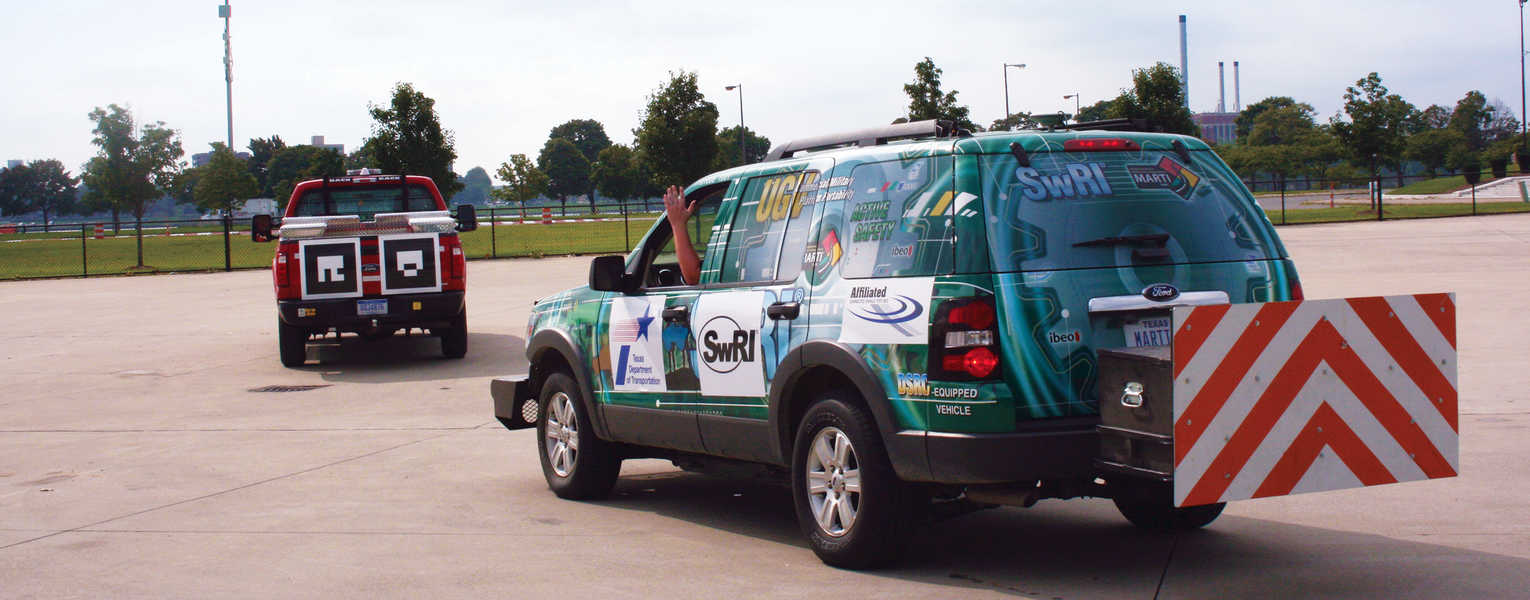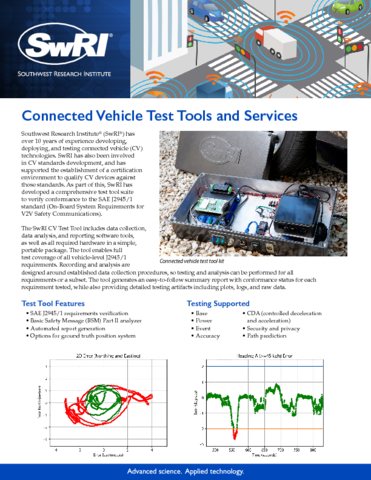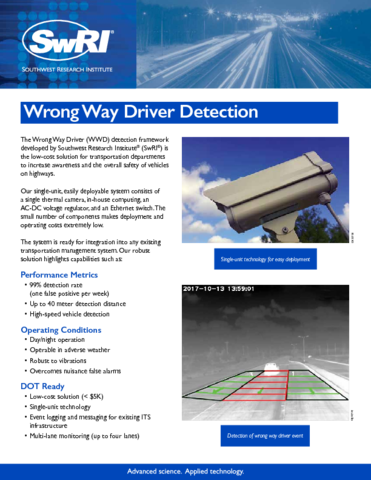A Connected vehicle (CV) network entails vehicles exchanging information with highway infrastructure and other vehicles using safe, interoperable wireless communications. Networked vehicles are designed to improve traffic safety and mobility, while minimizing environmental impacts. SwRI is a leading provider of software and systems research and development for connected vehicles, and we serve as a test bed for federal, state, and local agencies.
TECHNOLOGY OFFERINGS
Cooperative Vehicle-Infrastructure Situational Awareness System
Vulnerable road user safety remains a serious issue despite advances in enforcement, public awareness strategies, and improved infrastructure such as dedicated bicycle lanes. Automakers are implementing technology that utilizes vehicle sensors to warn drivers of the presence of pedestrians and bicyclists. However, sensors are often occluded from directly sensing the vulnerable road user due to buildings, other vehicles, and intersection geometries. Infrastructure-based sensing can in some cases be more robust, utilizing higher-end sensors and processors than can be accommodated on a vehicle.
Our cooperative vehicle-infrastructure situational awareness system leverages both vehicle-based and infrastructure-based sensing to build a comprehensive model of the immediate environment (e.g., highly dynamic intersections). It uses communications capabilities to share elements of that model with road users in and around the area. This system builds on SwRI’s expertise in automated vehicles, perception systems, and intelligent transportation systems to further improve safety for all road users.
Connected Vehicle Applications
The National Highway Traffic Safety Administration (NHTSA) has proposed a rule mandating vehicle-to-vehicle (V2V) communications to lessen crash risks. More vehicles are expected to be outfitted with dedicated short-range communication (DSRC) technology, which will enable vehicles to communicate with each other and an intelligent infrastructure. SwRI's experience and vision for the connected vehicle environment has led to collaboration and development of V2V and vehicle-to-infrastructure (V2I) applications for improving safety and mobility:
- Forward Collision Warning - Warns the driver of a potential collision with the vehicle in front, based on range and speed.
- Emergency Electronic Brake Lights - Warns the driver of a hard braking event by the vehicle in front.
- Emergency Vehicle Alerts - Supports first responders by warning drivers of the presence of an emergency vehicle, as well as providing information about its range, speed, and direction of approach.
- Platooning and Eco-Platooning - Fuses data from adjacent connected vehicles (e.g., position, speed, accelerations, and decelerations) to provide recommended target speeds to driver to improve longitudinal stability of a platoon of vehicles.
- Road Condition Monitoring - Fuses data from an inertial measurement unit (IMU) with DSRC position data to estimate the roughness of the road and identify distinct surface features (e.g., pot holes) to support road maintenance activities.
- Over-height Detection and Warning - Receives data from roadside sensors to identify situations where a commercial vehicle may be too tall for a bridge or overpass, and sends a warning to the driver through connected infrastructure that a collision may occur.
- Wrong-way Driver Warning - Detects vehicles that are traveling in the wrong direction on a road; warns the driver that they are going the wrong way; warns other drivers of the presence of a wrong way vehicle; and sends information through connected infrastructure to traffic management centers and emergency operations centers about the event.
Connected Vehicle Test Tools
As a member of the OmniAir Consortium, SwRI has supported development of testing tools and procedures for connected devices. These tools and procedures will support certification efforts that ensure devices conform to relevant industry standards and meet performance requirements. SwRI has developed and used test tools for vehicle onboard units (OBUs) as well as infrastructure-based road side units (RSUs). Our unique facilities allow us to support static bench testing, as well as mobile track testing of the devices.
These tools and procedures will support certification efforts by the U.S. Department of Transportation (USDOT) that ensure devices conform to relevant industry standards and meet performance requirements.



